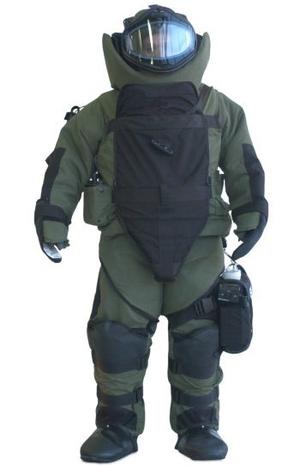Personal protection equipmentUniform bomb suits standard being developed
Several federal agencies are now working with first responders to create the first nationwide standard for minimum bomb suit performance requirements; having a standard will give some assurance of quality to DHS and other agencies that award grants to bomb squads for equipment purchases; if the standard is adopted, DHS will change its grants process to ensure awards are spent on bomb suits that meet the requirements

Improvements over the current bomb suit sought // Source: blastmagazine.com
Federal agencies are looking to protect the first responders and soldiers who check out and defuse potentially explosive devices with improved bomb suits.
These bulky protective suits worn by bomb technicians essentially serve as the only defense they have should a device go boom.
Bomb suit manufacturers run tests on their protective suits to ensure they can withstand an explosion, but there currently is no single set of requirements that the suits must meet before they can be sold.
TechNewsDaily reports that several federal agencies are now working with first responders to create the first nationwide standard for minimum bomb suit performance requirements.
“The bomb suit is such an important piece of equipment that a standard and certification program was needed to ensure a bomb technician’s safety,” said Martin Hutchings, a retiree of the Sacramento County, California sheriff’s department bomb squad and the National Institute of Standards and Technology liaison to the National Bomb Squad Commanders Advisory Board.
To develop the standard, federal agencies first researched the most common types of explosives bomb squads encounter, according to Philip Mattson, deputy director of the Office of Standards at DHS’s Science and Technology Directorate (S&T) Test & Evaluation and Standards Division.
Personnel at the U.S. Army Natick Soldier Research Development and Engineering Center blew up, burned, and projected fragments at suits to determine what kinds of tests the suits would need to pass to ensure they protect bomb technicians adequately.
The new drafted standard contains requirements for:
- cushioning the spine and head during impact;
- blast and thermal heat protection;
- freedom of motion to work efficiently;
- maximum weight restrictions;
- freedom of motion (allowing sufficient dexterity to pick up a coin from the ground); and
- defogger performance to prevent the helmet visor from clouding.
rapid removal, such as for emergency medical treatment;
Having a standard will give some assurance of quality to DHS and other agencies that award grants to bomb squads for equipment purchases, according to Mattson. If the standard is adopted, DHS will change its grants process to ensure awards are spent on bomb suits that meet the requirements.
The groups that worked to develop the standard hope it will be adopted by the end of 2010, and afterwards the standards will be reviewed every three to five years to ensure they meet the current needs of first responders.
“When it comes to a bomb suit, the practitioner’s life depends on the quality of that garment,” said Debra Stoe, senior program operations specialist and physical scientist at the National Institute of Justice.
